|
LIST
OF MESOPOTAMIAN DEITIES PART - 1
_-_EnKi_(Sumerian).jpg)
Akkadian
cylinder seal dating to c. 2300 BC, depicting the deities Inanna,
Utu, Enki, and Isimud
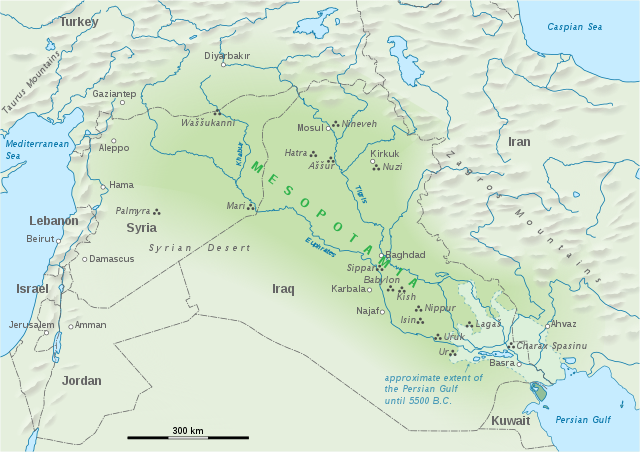
Map
showing the extent of Mesopotamia and its major cities relative
to modern landmarks
Deities
in ancient Mesopotamia were almost exclusively anthropomorphic.
They were thought to possess extraordinary powers and were often
envisioned as being of tremendous physical size. The deities typically
wore melam, an ambiguous substance which "covered them in
terrifying splendor" and which could also be worn by heroes,
kings, giants, and even demons. The effect that seeing a deity's
melam has on a human is described as ni, a word for the "physical
creeping of the flesh". Both the Sumerian and Akkadian languages
contain many words to express the sensation of ni, including the
word puluhtu, meaning "fear". Deities were almost always
depicted wearing horned caps, consisting of up to seven superimposed
pairs of ox-horns. They were also sometimes depicted wearing clothes
with elaborate decorative gold and silver ornaments sewn into
them.
The
ancient Mesopotamians believed that their deities lived in Heaven,
but that a god's statue was a physical embodiment of the god himself.
As such, cult statues were given constant care and attention and
a set of priests were assigned to tend to them. These priests
would clothe the statues and place feasts before them so they
could "eat". A deity's temple was believed to be that
deity's literal place of residence. The gods had boats, full-sized
barges which were normally stored inside their temples and were
used to transport their cult statues along waterways during various
religious festivals. The gods also had chariots, which were used
for transporting their cult statues by land. Sometimes a deity's
cult statue would be transported to the location of a battle so
that the deity could watch the battle unfold. The major deities
of the Mesopotamian pantheon were believed to participate in the
"assembly of the gods", through which the gods made
all of their decisions. This assembly was seen as a divine counterpart
to the semi-democratic legislative system that existed during
the Third Dynasty of Ur (c. 2112 BC – c. 2004 BC).
The
Mesopotamian pantheon evolved greatly over the course of its history.
In general, the history of Mesopotamian religion can be
divided into four phases. During the first phase, starting in
the fourth millennium BC, deities' domains mainly focused on basic
needs for human survival. During the second phase, which occurred
in the third millennium BC, the divine hierarchy became more structured
and deified kings began to enter the pantheon. During the third
phase, in the second millennium BC, the gods worshipped by an
individual person and gods associated with the commoners became
more prevalent. During the fourth and final phase, in the first
millennium BC, the gods became closely associated with specific
human empires and rulers. The names of over 3,000 Mesopotamian
deities have been recovered from cuneiform texts. Many of these
are from lengthy lists of deities compiled by ancient Mesopotamian
scribes. The longest of these lists is a text entitled An = Antum,
a Babylonian scholarly work listing the names of over 2,000 Sumerian
deities with their Semitic equivalents.
The
Anunnaki are a group of deities first attested during the reign
of Gudea (c. 2144 – 2124 BC) and the Third Dynasty of Ur.
Originally, the Anunnaki appear to have been heavenly deities
with immense powers, who were believed to "decree the fates
of mankind". Later they became regarded as chthonic Underworld
deities. They are chiefly mentioned in literary texts and very
little evidence to support the existence of any cult of them has
yet been unearthed. This is likely due to the fact that each member
of the Anunnaki had his or her own individual cult, separate from
the others. Similarly, no representations of the Anunnaki as a
group have yet been discovered, although a few depictions of its
individual members have been identified. Another group of deities
are the Igigi, who are first attested from the Old Babylonian
Period (c. 1830 BC – c. 1531 BC). The name Igigi seems to
have originally been applied to the ten "great gods",
but it later came to refer to all the gods of Heaven collectively.
In some instances, the terms Anunnaki and Igigi are used synonymously.
Triad
of Heaven :
The three most important deities in the Mesopotamian pantheon
during all periods were the deities An, Enlil, and Enki. An was
identified with all the stars of the equatorial sky, Enlil with
those of the northern sky, and Enki with those of the southern
sky. The path of Enlil's celestial orbit was a continuous, symmetrical
circle around the north celestial pole, but those of An and Enki
were believed to intersect at various points.
Name |
Particulars |
| An
/ Anu |

Major
cult centers : Eanna temple in Uruk
Celestial
body
: Equatorial sky
Associated
color : Luludanitu; ensemble of red, white
and black
Details
:
An
(in Sumerian), later known as Anu or Ilu (in Akkadian),
is the supreme God and "prime mover in creation",
embodied by the sky. He is the first and most
distant ancestor, theologically conceived as the
God of Heaven in its "transcendental obscurity".
All the deities were believed to be the offspring
of An and his consort Ki (cf. Anunnaki).
While An was the utmost God, at least by the time
of the earliest written records the cult was largely
devoted to Enlil. |
| Enlil
Nunamnir, Ellil |
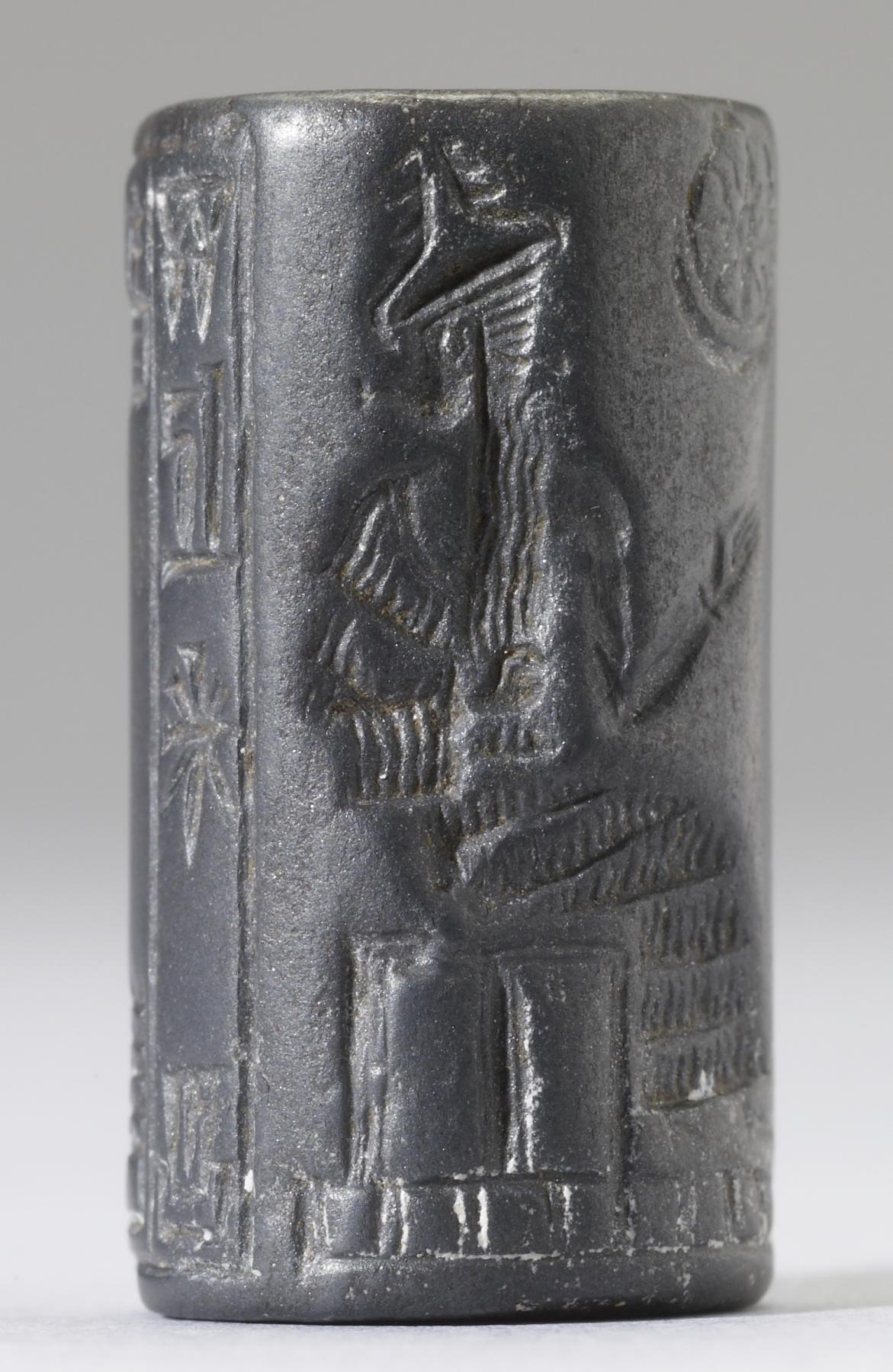
Major
cult centers : Ekur
temple in Nippur
Celestial
body
: Northern sky
Associated
color : Lapis lazuli-blue
Details
:
Enlil,
later known as Ellil, is the god of wind, air,
earth, and storms and the chief of all the gods.
He is theologically conceived as the "transcendent"
facet of An. The Sumerians envisioned Enlil as
a benevolent, fatherly deity, who watches over
humanity and cares for their well-being. One Sumerian
hymn describes Enlil as so glorious that even
the other gods could not look upon him. His cult
was closely tied to the holy city of Nippur and,
after Nippur was sacked by the Elamites in 1230
BC, his cult fell into decline. He was eventually
paralleled in his role as chief deity by Marduk,
the national god of the Babylonians. |
| Enki
/ Nudimmud, Ninshiku, Ea |
Major
cult centers : E-Abzu temple in Eridu
Celestial
body
: Southern sky
Associated
color : Jasper-green
Details
:
Enki,
later known as Ea, and also occasionally referred
to as Nudimmud or Ninšiku, is the god of the subterranean
freshwater ocean, who is also closely associated
with wisdom, magic, incantations, arts, and crafts.
He is either the son of An, or the goddess Nammu,
and is the twin brother of Ishkur. He is theologically
conceived as the "immanent" facet of An. His wife
is the goddess Damgalnuna (Ninhursag) and his
sons include the gods Marduk, Asarluhi, Enbilulu,
the sage Adapa, and the goddess Nanshe. His sukkal,
or minister, is the two-faced messenger god Isimud.
Enki is the divine benefactor of humanity, who
helped humans survive the Great Flood. In Enki
and the World Order, he organizes "in detail
every feature of the civilised world." In Inanna
and Enki, he is the holder of the sacred mes,
the tablets concerning all aspects of human life.
|
|
Seven
planetary deities :
The number
seven was extremely important in ancient Mesopotamian cosmology.
In Sumerian religion, the most powerful and important deities
in the pantheon were the "seven gods who decree": An,
Enlil, Enki, Ninhursag, Nanna, Utu, and Inanna. Many major deities
in Sumerian mythology were associated with specific celestial
bodies: Inanna was believed to be the planet Venus, Utu was believed
to be the Sun, and Nanna was the Moon. Later Mesopotamian peoples
adopted these associations and also assigned their own deities
to the classical planets until all seven celestial bodies visible
with the naked eye had become identified with major deities. The
modern seven-day week originated with the ancient Babylonians,
for whom each day was associated with one of the seven planetary
deities.
Name |
Particulars |
| Utu
/ Shamash |
.jpg)
Major
cult centers : E-Babbar temples at Sippar and Larsa
Celestial
body
: Sun
Associated
color : Gold, yellow
Details
:
Utu,
later known as Shamash, is the ancient Mesopotamian
god of the Sun, who was also revered as the god
of truth, justice, and morality. He was the son
of Nanna, the younger brother of Ereshkigal, and
the twin brother of Inanna. Utu was believed to
see all things that happen during the day and to
aid mortals in distress. Alongside Inanna, Utu was
the enforcer of divine justice. |
| Nanna-Suen
Nanna, Enzu, Zuen, Suen, Sin |

Major
cult centers : E-kiš-nu-gal
temple in Ur and another temple in Harran
Celestial
body
: Moon
Associated
color : Silver, green
Details
:
Nanna,
Enzu or Zuen ("Lord of Wisdom") in Sumerian, later
altered as Suen and Sin in Akkadian, is the ancient
Mesopotamian god of the Moon. He was the son of
Enlil and Ninlil and one of his most prominent
myths was an account of how he was conceived and
how he made his way from the Underworld to Nippur.
The Moon-god has an important role among the major
gods; in Assyrian esoteric literature, he is regarded
as symbolizing the pleroma, i.e. the sum
of all the gods' powers, and thus An itself. The
crescent of the Moon-god was featured on the top
of the cusps of Mesopotamian temples.
|
| Nergal
|
Major
cult centers : E-Meslam temple in Kutha and Mashkan-shapir
Celestial
body
: Mars
Associated
color : Iron, red
Details
:
Nergal
was associated with the Underworld and is usually
the husband of Ereshkigal. He was also associated
with forest fires (and identified with the fire-god,
Gibil), fevers, plagues, and war. In myths, he causes
destruction and devastation. |
| Nabu
|
Major
cult centers : Borsippa
Celestial
body
: Mercury
Associated
color : Mercury, orange
Details
:
Nabu
was the Mesopotamian god of scribes and writing.
His wife was the goddess Tashmetu and he may have
been associated with the planet Mercury. He later
became associated with wisdom and agriculture. |
| Marduk
|
Major
cult centers : Babylon
Celestial
body
: Jupiter
Associated
color : Tin, white
Details
:
Marduk
is the national god of the Babylonians. The expansion
of his cult closely paralleled the historical rise
of Babylon and, after assimilating various local
deities, including a god named Asarluhi, he eventually
came to parallel Enlil as the chief of the gods.
His wife was the goddess Sarpanitu. |
| Inanna
/ Ishtar |
Major
cult centers : Eanna temple in Uruk, though she
also had temples in Nippur, Lagash, Shuruppak, Zabalam,
and Ur
Celestial
body
: Venus
Associated
color : Copper, blue
Details
:
Inanna,
later known as Ishtar, is "the most important female
deity of ancient Mesopotamia at all periods." She
was the Sumerian goddess of love, beauty and war.
She was the divine personification of the planet
Venus, the morning and evening star. Alongside her
twin brother Utu, Inanna was the enforcer of divine
justice. |
| Ninurta
/ Ningirsu |
Major
cult centers : E-šu-me-ša temple in Nippur,Girsu, Lagash, and later Kalhu in Assyria
Celestial
body
: Saturn
Associated
color : Lead, black
Details
:
Ninurta,
also known as Ningirsu, was a Mesopotamian warrior
deity who was worshipped in Sumer from the very
earliest times. He was the champion of the gods
against the Anzű bird after it stole the Tablet
of Destinies from his father Enlil and, in a myth
that is alluded to in many works but never fully
preserved, he killed a group of warriors known as
the "Slain Heroes". Ninurta was also an agricultural
deity and the patron god of farmers. In the epic
poem Lugal-e, he slays the demon Asag and
uses stones to build the Tigris and Euphrates rivers
to make them useful for irrigation. His major symbols
were a perched bird and a plow. |
|
Primordial
beings :
Various civilizations over the course of Mesopotamian history had
many different creation stories. The earliest accounts of creation
are simple narratives written in Sumerian dating to the late third
millennium BC. These are mostly preserved as brief prologues to
longer mythographic compositions dealing with other subjects, such
as Inanna and the Huluppu Tree. The Creation of the Pickax, and
Enki and Ninmah. Later accounts are far more elaborate, adding multiple
generations of gods and primordial beings. The longest and most
famous of these accounts is the Babylonian Enûma Eliš,
or Epic of Creation, which is divided into seven tablets. The surviving
version of the Enûma Eliš could not have been written
any earlier than the late second millennium BC, but it draws heavily
on earlier materials, including various works written during the
Akkadian, Old Babylonian, and Kassite periods in the early second
millennium BC.
Name |
Details |
| Abzu
|
Abzu
was the personification of the subterranean primeval
waters. |
| Anshar
and Kishar |
In
some East Semitic myths, Anshar and Kishar are a
primordial couple, who are male and female respectively.
In the Babylonian Enűma Eliš, they are the
second pair of offspring born from Abzu and Tiamat
and the parents of the supreme An. |
| Ki
|
Ki
is the Sumerian goddess personifying the earth itself.
In some Sumerian accounts, she is a primordial being
who copulates with An to produce a variety of plants.
Ki is the mother of Enlil and the Sumerians believed
that the world began when Enlil separated her from
An. She may be another name for Ninhursag, the earth
goddess. |
| Nammu |
Nammu
is the primordial goddess who, in some Sumerian
traditions, was said to have given birth to both
An and Ki. She eventually came to be regarded as
the mother of Enki and was revered as an important
mother goddess. Because the cuneiform sign used
to write her name is the same as the sign for engur,
a synonym for abzu, it is highly probable
that she was originally conceived as the personification
of the subterranean primeval waters. |
| Tiamat |

In
the Babylonian creation epic, the Enűma Eliš,
after the separation of heaven and earth, the goddess
Tiamat and her consort Abzu are the only deities
in existence. A male-female pair, they mate and
Tiamat gives birth to the first generation of gods.
|
|
Other
major deities :
Name |
Particulars |
| Ashur
|

Major
cult centers : Assur
Details
:
Ashur
is the national god of the Assyrians, who was syncretized
with Enlil. He may have originally been a local
deity associated with the city of Assur, but, with
the growth of the Assyrian Empire, his cult was
introduced to southern Mesopotamia. |
| Dagan
/ Dagon |
Major
cult centers : Mari, Ebla, and Ugarit
Details
:
Dagan
is a West Semitic god of grain who came to be worshipped
across the entire Near East, including in Mesopotamia.
According to one tradition, Dagan was the inventor
of the plough. Dagan was assimilated into the Sumerian
pantheon at an early date as a minor attendant deity
to Enlil. His cult was extensively promoted by the
Babylonian king Hammurabi, who claimed that Dagan
had allowed him to conquer all of Mesopotamia. In
an Assyrian poem, Dagan is one of the judges of
the Underworld. Although Dagan was once mistakenly
assumed to appear in artwork as a fish-garbed figure,
this is now known to be inaccurate. |
| Dumuzid
/ Tammuz |

Major
cult centers : Bad-tibira and Kuara
Details
:
Dumuzid,
later known by the corrupted form Tammuz, is the
ancient Mesopotamian god of shepherds. His sister
is the goddess Geshtinanna. In addition to being
the god of shepherds, Dumuzid was also an agricultural
deity associated with the growth of plants. Ancient
Near Eastern peoples associated Dumuzid with the
springtime, when the land was fertile and abundant,
but, during the summer months, when the land was
dry and barren, it was thought that Dumuzid had
"died". During the month of Dumuzid, which fell
in the middle of summer, people all across Sumer
would mourn over his death. An enormous number of
popular stories circulated throughout the Near East
surrounding his death. |
| Ereshkigal
|
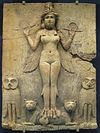
Major
cult centers : Kutha
Details
:
Ereshkigal
is the queen of the Mesopotamian Underworld. She
lived in a palace known as Ganzir. In earlier stories,
her husband is Gugalanna, but, in later myths, her
husband is the god Nergal. Her gatekeeper was the
god Neti and her sukkal is the god Namtar.
In the poem Inanna's Descent into the Underworld,
Ereshkigal is described as Inanna's "older sister".
|
| Geshtinanna
|
Major
cult centers : Nippur, Isin, and Uruk
Details
:
Geshtinanna
is a rural agricultural goddess sometimes associated
with dream interpretation.She is the sister of Dumuzid, the god of shepherds.
In one story, she protects her brother when the
galla demons come to drag him down to the
Underworld by hiding him in successively in four
different places. In another version of the story,
she refuses to tell the galla where he is
hiding, even after they torture her. The galla
eventually take Dumuzid away after he is betrayed
by an unnamed "friend", but Inanna decrees that
he and Geshtinanna will alternate places every six
months, each spending half the year in the Underworld
while the other stays in Heaven. While she is in
the Underworld, Geshtinanna serves as Ereshkigal's
scribe. |
| Gilgamesh
|
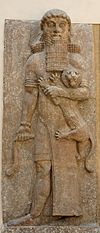
Major
cult centers : Uruk and a small village near Ur
Details
:
Most
historians generally agree that Gilgamesh was a
historical king of the Sumerian city-state of Uruk,
who probably ruled sometime during the early part
of the Early Dynastic Period (c.
2900–2350 BC). It is certain that, during the later
Early Dynastic Period, Gilgamesh was worshipped
as a god at various locations across Sumer. In the
twenty-first century BC, Utu-hengal, the king of
Uruk adopted Gilgamesh as his patron deity. The
kings of the Third Dynasty of Ur were especially
fond of Gilgamesh, calling him their "divine brother"
and "friend". During this period, a large number
of myths and legends developed surrounding him.
Probably during the Middle Babylonian Period (c.
1600 BC – c. 1155 BC),
a scribe named Sîn-leqi-unninni composed the Epic
of Gilgamesh, an epic poem written in Akkadian
narrating Gilgamesh's heroic exploits. The opening
of the poem describes Gilgamesh as "one-third human,
two-thirds divine". |
| Gula
/ Nintinugga, Ninkarrak, Meme, Bau, Ninisina
|

Major
cult centers : E-gal-mah temple in Isin and other
temples in Nippur, Borsippa, and Assur
Details
:
Gula,
also known as Nintinugga, Ninkarrak, Meme, Bau,
and Ninisina, is the Mesopotamian goddess of healing
and the divine patroness of doctors and medicine-workers.
Dogs were considered sacred to her and she is often
shown in art with a dog sitting beside her. She
is sometimes the wife of Ninurta or Pabilsag, but
is also sometimes described as being married to
the minor vegetation god Abu. |
| Ishkur
/ Adad |
Major
cult centers : Karkara and Assur
Details
:
Ishkur,
later known as Adad, is the Mesopotamian god of
storms and rain. He was sometimes syncretized with
the Hurrian god Teshub and the Kassite god Buriash.
His wife is the goddess Shala. He is usually the
son of An, but, in older traditions, he is the son
of Enlil. |
| Ištaran
|
Major
cult centers : Der
Details
:
Ištaran
is a local god of the Sumerian city-state of Der,
which was located east of the Tigris river on the
border between Mesopotamia and Elam. His wife is
the goddess Šarrat-Deri, whose name means "Queen
of Der", and his sukkal was the snake-god
Nirah. A text from the late Early Dynastic Period
invokes Ištaran to resolve a boundary dispute between
the cities of Lagash and Umma. In one of his inscriptions,
King Gudea of Lagash mentions himself having installed
a shrine for Ištaran in the temple of Ningirsu at
Girsu and describes Ištaran as a god of justice.
On kudurrus (boundary stones), Ištaran is
often represented by a serpent, which may be Nirah
or Ištaran himself. In a ritual associated with
the Ekur temple in Nippur, Ištaran is a "dying god"
and is equated with Dumuzid. His cult fell into
decline during the Middle Babylonian Period, after
which point he no longer appears in personal names. |
| Nanshe
|
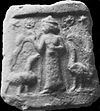
Major
cult centers : Lagash
Details
:
Nanshe
is a local goddess associated with the city of Lagash.
She is the daughter of Enki and the sister of Ningirsu.
She is associated with divination and the interpretation
of dreams She was also believed to assist the poor
and the impoverished and ensure the accuracy of
weights and measurements. |
| Ninazu
|
Major
cult centers : Eshnunna (later replaced by the Hurrian
storm god Tishpak)
Details
:
Ninazu
is the son of Ereshkigal and the father of Ningishzida.
He is closely associated with the Underworld. He
was mostly worshipped in Eshnunna during the third
millennium BC, but he was later supplanted by the
Hurrian storm god Tishpak. A god named "Ninazu"
was also worshipped at Enegi in southern Sumer,
but this may be a different local god by the same
name. His divine beast was the mušhuššu,
a kind of dragon, which was later given to Tishpak
and then Marduk. |
| Ningal
/ Nikkal |
Major
cult centers : Ur and Harran
Details
:
Ningal,
later known by the corrupted form Nikkal, was the
wife of Nanna-Suen, the god of the moon, and the
mother of Utu, the god of the sun. |
| Ningishzida
|

Major
cult centers : Lagesh
Details
:
Ningishzida
is a god who normally lives in the Underworld. He
is the son of Ninazu and his name may be etymologically
derived from a phrase meaning "Lord of the Good
Tree". In the Sumerian poem, The Death of Gilgamesh,
the hero Gilgamesh dies and meets Ningishzida, along
with Dumuzid, in the Underworld. Gudea, the Sumerian
king of the city-state of Lagash, revered Ningishzida
as his personal protector. In the myth of Adapa,
Dumuzid and Ningishzida are described as guarding
the gates of the highest Heaven. Ningishzida was
associated with the constellation Hydra. |
Ninhursag
/ Damgalnuna, Ninmah |

Major
cult centers : E-Mah temple in Adab
Details
:
Ninhursag,
also known as Damgalnuna and Ninmah, is the Sumerian
mother goddess, who was associated with agricultural
fertility. Many of the gods are her offspring, and
many mortal rulers claimed her as their mother as
well. She is also Enki's primary consort. Her main
temple was the E-Mah in Adab, but she was also associated
with the city of Kesh and she is sometimes referred
to as the "Belet-ili of Kesh" or "she of Kesh".
One of her main symbols is a divine emblem resembling
the later Greek letter omega. |
| Ninlil
|
Major
cult centers : Nippur and Assur
Details
:
Ninlil
was the wife of Enlil, the ruler of the gods. She
was probably an artificially created deity, invented
as a female equivalent to Enlil. She was regarded
as having power on par with Enlil; in one poem,
Ninlil declares, "As Enlil is your master, so am
I also your mistress!" |
| Ninshubur
|

Major
cult centers : Worshipped with Inanna as her sukkal
Details
:
Ninshubur
is the sukkal, or personal attendant, to
the goddess Inanna. She is portrayed as "unshakably
loyal" in her devotion to her mistress. In the Sumerian
myth of Inanna and Enki, Ninshubur rescues
Inanna from the monsters that Enki sends to capture
her. In the Sumerian myth of Inanna's Descent
into the Underworld, Ninshubur pleads with all
the gods in effort to persuade them to rescue Inanna
from the Underworld. In addition to being a source
of great wisdom and knowledge, Ninshubur was also
a warrior goddess. She was the guardian and messenger
of the god An. She is said to have walked in front
of An wherever he went, a position traditionally
reserved for a bodyguard.In later Akkadian mythology, Ninshubur was
syncretized with the male messenger deity Papsukkal. |
| Nisaba |
Major
cult centers : Lagash, Umma, and later Eresh
Details
:
Nisaba,
also known as Nanibgal, was originally a goddess
of grain and agriculture, but, starting in the Early
Dynastic Period, she developed into a goddess of
writing, accounting, and scribal knowledge. She
was the daughter of Enlil and the sister of Ningirsu.
In earlier times, her husband was the god Haya,
but, in later times, she came to be regarded as
the wife of Nabu, the god of scribes. |
|
Minor
deities :
Name |
Particulars |
| Ama-arhus
|
Major
cult centers : Uruk
Details
: Ama-arhus
is a fertility goddess who was worshipped in Uruk
during the Hellenistic Period. |
| Amasagnul
|
Details
: Amasagnul
is a goddess who is thought to have been the consort
of the messenger god Papsukkal. |
| Amashilama |

Details
: In
the collection of laments entitled In the Desert
by the Early Grass, Amashilama is a divine leech
and the sister of the god Damu, who has died and
gone to the Underworld. At her son's request, Damu's
mother digs up his blood and chops it into pieces.
She gives the congealed blood to Amashilama, who
mixes it into a brew of beer, which Damu must drink
in order to be restored to life. Damu, however,
realizes that he is dead and declares that he is
not in the "grass which shall grow for his mother
again", nor in the "waters which will rise". Damu's
mother blesses him and Amashilama dies to join him
in the Underworld. She tells him that "the day that
dawns for you will also dawn for me; the day you
see, I shall also see", referring to the fact that
day in the world above is night in the Underworld. |
| Antu
|

Details
:
Antu
is a goddess who was invented during the Akkadian
Period (c. 2334 BC –
2154 BC) as a consort for Anu. Her name is a female
version of Anu's own. The Akkadians believed that
rain was milk from the clouds, which they believed
were Antu's breasts. According to the German classical
scholar Walter Burkert, the Greek goddess Dione,
mentioned in Book V of the Iliad as the mother
of Aphrodite, is probably a calque for Antu. |
| Anunitu
|
Major
cult centers : Agade and Sippar
Details
:
Anunitu
was a minor Babylonian goddess who was believed
to aid women in childbirth. She was later considered
to be merely an aspect of Inanna. Eventually, this aspect of Inanna became
associated with the constellation Pisces. |
| Asarluhi |
Major
cult centers : Kuara
Details
:
Asarluhi
was originally a local god of the village of Kuara,
which was located near the city of Eridu. He eventually
became regarded as a god of magical knowledge and
was thought to be the son of Enki and Ninhursag.
He was later absorbed as an aspect of Marduk. In
the standard Babylonian magical tradition, the name
"Asarluhi" is used as merely an alternative name
for Marduk. |
| Ashgi
|
Major
cult centers : Adab and Kesh
Details
:
Ashgi
is the brother of the goddess Lisin. |
| Ashnan
|
Details
:
Ashnan
is the goddess of grain. In the Sumerian poem The
Dispute between Cattle and Grain, she and her
sister Lahar are created by the Anunnaki to provide
them with food. They produce large amounts of food,
but become drunk with wine and start to quarrel,
so Enki and Enlil intervene, declaring Ashnan the
victor. |
| Aruru
|
Details
:
Aruru
is a mother goddess, possibly the same as Ninhursag. |
| Bel
of Babylon |
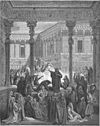
Major
cult centers : Babylon
Details
:
During
the first millennium BC, the Babylonians worshipped
a deity under the title "Bel", meaning "lord", who
was a syncretization of Marduk, Enlil, and the dying
god Dumuzid. Bel held all the cultic titles of Enlil
and his status in the Babylonian religion was largely
the same. Eventually, Bel came to be seen as the
god of order and destiny. The cult of Bel is a major
component of the Jewish story of "Bel and the Dragon"
from the apocryphal additions to Daniel. |
| Belet-Seri
|
Details
:
Belet-Seri
is a chthonic Underworld goddess who was thought
to record the names of the deceased as they entered
the Underworld. |
| Birtum
|
Details
:
Birtum
is an obscure minor god, the husband of the goddess
Nungal. |
| Bull
of Heaven |
 Details
:
Details
:
The
Bull of Heaven is a mythical beast that Ishtar demands
from her father Anu in both the Sumerian poem Gilgamesh
and the Bull of Heaven and in Tablet VI of the
Standard Akkadian Epic of Gilgamesh. Anu
gives it to her and she unleashes it on the world,
causing mass destruction. Gilgamesh and Enkidu eventually
slay the bull. The Bull of Heaven is identified
with the constellation Taurus and the reason why
Enkidu hurls the bull's thigh at Ishtar in the Epic
of Gilgamesh after defeating it may be an effort
to explain why the constellation seems to be missing
its hind quarters. |
| Bunene
|
Major
cult centers : Sippar, Uruk, and Assur
Details
:
Bunene
is the sukkal and charioteer of the sun-god
Utu. He was worshipped at Sippar and Uruk during
the Old Babylonian Periodand was later worshipped at Assur. According
to some accounts, he may have been Utu's son. |
| Damu
|
Major
cult centers : Isin, Larsa, Ur, and Girsu
Details
:
Damu
is a god who presides over healing and medicine.
He is usually the son of Ninisina and Ningishzida,
or is identical to Ningishzida himself. In some texts, "Damu" is used as another
name for Dumuzid, but this may be a different word
meaning "son". Another god named "Damu" was also
worshipped in Ebla and Emar, but this may be a local
hero, not the same as the god of healing. The official
cult of Damu became extinct sometime after the Old
Babylonian Period. |
| Dingirma
|
Details
:
Dingirma
is a mother goddess whose name means "exalted deity".
She may just be another name for Ninhursag. |
| Dumu-zi-abzu
|
Major
cult centers : Kinunir
Details
:
Dumu-zi-abzu
is a local goddess who was worshipped in the village
of Kinunir, near the city-state of Lagash. Her name,
which probably means "good child of the Abzu", was
sometimes abbreviated to Dumu-zi, but she
has no obvious connection to the god Dumuzid. |
| Emesh
|
Details
:
Emesh
is a farmer deity in the Sumerian poem Enlil
Chooses the Farmer-God (ETCSL 5.3.3), which
describes how Enlil, hoping "to establish abundance
and prosperity", creates two gods: Emesh and Enten,
a farmer and a shepherd respectively. The two gods
argue and Emesh lays claim to Enten's position.
They take the dispute before Enlil, who rules in
favor of Enten. The two gods rejoice and reconcile. |
| Enkimdu
|
Details
: Enkimdu
is described as the "lord of dike and canal". He
appears in the myth of Inanna Prefers the Farmer
as a wealthy farmer who competes with Dumuzid. He
is the son of Enki and is closely associated with
Enbilulu. He is sometimes identified as a form of
Ishkur or as an alternate name for Marduk. |
| Enmesharra |
Details
: Enmesharra
is a minor deity of the Underworld. Seven or eight
other minor deities were said to be his offspring.
His symbol was the suššuru (a kind of pigeon).
In one incantation, Enmesharra and Ninmesharra,
his female counterpart, are invoked as ancestors
of Enki and as primeval deities. |
| Ennugi
|
Details
: Ennugi
is "the canal inspector of the gods". He is the
son of Enlil or Enmesarra and his wife is the goddess
Nanibgal. He is associated with the Underworld and
he may be Gugalanna, the first husband of Ereshkigal,
under a different name. |
| Enten
|
Details
: Enten
is a shepherd deity in the Sumerian poem Enlil
Chooses the Farmer-God (ETCSL 5.3.3), which
describes how Enlil, hoping "to establish abundance
and prosperity", creates two gods: Emesh and Enten,
a farmer and a shepherd respectively. The two gods
argue and Emesh lays claim to Enten's position.
They take the dispute before Enlil, who rules in
favor of Enten. The two gods rejoice and reconcile. |
| Enzag
|
Major
cult centers : Dilmun
Details
:
Enzag
is one of several deities created by the sexual
union of Enki and Ninhursag. He is described as
the "lord of Dilmun". In another text, he is referred
to as the "Nabu of Dilmun". |
| Erra
|
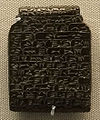 Details
:
Details
:
Erra
is a warlike god who is associated with pestilence
and violence. He is the son of the sky-god An and
his wife is an obscure, minor goddess named Mami,
who is different from the mother goddess with the
same name. As early as the Akkadian Period, Erra
was already associated with Nergal and he eventually
came to be seen as merely an aspect of him. The
names came to be used interchangeably. |
| Erragal
/ Errakal |
Details
:
Erragal,
also known as Errakal, is a relatively rarely-attested
deity who was usually regarded as a form of Erra,
but the two gods are probably of separate origin.
He is connected with storms and the destruction
caused by them. In An = Anum I 316, Erragal
is listed as the husband of the goddess Ninisig
and is equated with Nergal. in the Epic of Gilgamesh
and the Atra-Hasis Epic, Errakal is said
to "tear up the mooring poles", causing the Great
Flood. |
| Gareus |
Major
cult centers : Uruk
Details
: Gareus
was a god introduced to Uruk during late antiquity
by the Parthians, who built a small temple to him
there in around 100 AD. He was a syncretic deity,
combining elements of Greco-Roman and Babylonian
cults. |
| Gatumdug |
Major
cult centers : Lagash and later Girsu
Details
: Gatumdug
is a goddess associated with the city-state of Lagash.
She was later equated with Bau. |
| Gibil
|
 Details
:
Details
:
Gibil
is the deification of fire. As such, he represents
fire in all of its destructive and creative aspects.
According to Jeremy Black and Anthony Green, he
"represented fire in all its aspects: as a destructive
force and as the burning heat of the Mesopotamian
summer; and as a creative force, the fire in the
blacksmith's furnace and the fire in the kiln where
bricks are baked, and so as a 'founder of cities'."
He is traditionally said to be the son of An and
Shala, but is sometimes the son of Nusku. |
| Gugalanna |
Details
:
Introduced
to Uruk during late antiquity by the Gugalanna is
the first husband of Ereshkigal, the queen of the
Underworld. His name probably originally meant "canal
inspector of An" and he may be merely an alternative
name for Ennugi. The son of Ereshkigal and Gugalanna
is Ninazu. In Inanna's Descent into the Underworld,
Inanna tells the gatekeeper Neti that she is descending
to the Underworld to attend the funeral of "Gugalanna,
the husband of my elder sister Ereshkigal". |
| Gunura
|
Details
: Gunura
is a deity of uncertain status. The deity is described
in some sources as the husband of the goddess Ninsun
and the father of Damu, but in other sources as
the sister of Damu. |
| Hahanu
|
Details
: Hahanu
is an obscure god of uncertain function who is referenced
in passing by several inscriptions. |
| Hanbi |
Details
: Hanbi
is the father of the demon-god Pazuzu. |
| Hani
|
Details
: Hani
is a minor East Semitic deity. He is the sukkal
to the storm-god Adad. |
| Haya |
Major
cult centers : Lagash and later Girsu
Details
:
Haya
is the husband of the goddess Nisaba. Haya was primarily
a god of scribes, but he may have also been associated
with grain and agriculture. He also served as a
doorkeeper. In some texts, he is identified as the
father of the goddess Ninlil. He was worshipped
mostly during the Third Dynasty of Ur, when he had
temples in the cities of Umma, Ur, and Kuara. In
later times, he had a temple in the city of Assur
and may have had one in Nineveh. A god named Haya
was worshipped at Mari, but this may have been a
different deity. |
| Hayasum |
Details
:
Hayasum
is a minor god who is referenced in some inscriptions,
but whose function is unknown. |
| Hegir-Nuna
/ Gangir |
Details
:
Hegir-Nuna,
also known as Gangir, is one of the seven daughters
of Baba. |
| Hendursag
|
Details
:
Hendursag
was a Sumerian god of law. King Gudea of Lagash
refers to him as the "herald of the land of Sumer"
in one inscription. |
| Ig-alima |
Major
cult centers : Lagash
Details
:
Ig-alima
is the son of Bau and Ningirsu. |
| Ilaba
|
Major
cult centers : Agade
Details
:
Ilaba
was briefly a major deity during the Akkadian Period,
but seems to have been completely obscure during
all other periods of Mesopotamian history. He was
closely associated with the kings of the Akkadian
Empire. |
| Ilabrat
|
Major
cult centers : Worshipped with Anu as his sukkal
Details
:
Ilabrat
is the sukkal, or personal attendant, of
the god Anu. He appears in the myth of Adapa in
which he tells Anu that the reason why the south
wind does not blow is because Adapa, the priest
of Ea in Eridu, has broken its wing. |
| Imdugud |
 Details
:
Details
:
Imdugud,
later known as Anzű, is an enormous bird-like monster
with the head of a lion that was so huge that the
flapping of its wings was thought to be the cause
of sandstorms and whirlwinds. Imdugud probably originated
as the personification of atmospheric fog. In some
descriptions, he has a "beak like a saw", indicating
that he sometimes had the head of a bird. In Sumerian
mythology, Imdugud steals the sacred mes
(the clay tablets recording all the aspects of civilization)
from Enki. In Akkadian mythology, he steals the
Tablet of Destinies from Enlil. In both stories,
Imdugud is challenged by Ninurta, who defeats him
and returns the stolen property to its rightful
owner. In the Sumerian story of Gilgamesh, Enkidu,
and the Netherworld, Imdugud is one of several
creatures that come to inhabit the huluppu
tree planted by Inanna and is driven off by the
hero Gilgamesh. |
| Išhara
|
Major
cult centers : Middle Euphrates region
Details
:
Išhara
is a mainly Semitic goddess who was primarily associated
with love, but who is also a goddess of war and
extispacy, and sometimes a mother goddess. She was
equated with Ishtar from early on. In early times,
her sacred animal is the snake, but, in later times,
it is the scorpion. She is identified with the constellation
Scorpius. An important goddess with the same name
as her was also worshipped by the Hurrians in southeast
Anatolia and northwest Syria as an Underworld goddess. |
| Isimud
|

Major
cult centers : Worshipped with Enki as his sukkal
Details
:
Isimud,
later known as Usmű, is the sukkal, or personal
attendant, to the god Enki. His name is related
to the word meaning "having two faces" and he is
shown in art with a face on either side of his head.
He acts as Enki's messenger in the myths of Enki
and Ninhursag and Inanna and Enki. |
| Ishum
|
Details
:
Ishum
was a popular, but not very important god, who was
worshipped from the Early Dynastic Period onwards.
In one text, he is described as the son of Shamash
and Ninlil. He was a generally benevolent deity,
who served as a night watchman and protector. He
may be the same god as the Sumerian Hendursag, because
the both of them are said to have been the husband
of the goddess Ninmug. He was sometimes associated
with the Underworld and was believed to exert a
calming influence on Erra, the god of rage and violence. |
| Kakka |
Details
:
Kakka
is a sukkal to both Anu and Anshar who plays
a role in the text of Nergal and Ereshkigal.
|
| Kittu
|
Details
:
Kittu
is the daughter of Utu and Sherida. Her name means
"Truth". |
| Kus |
Details
:
Kus
is a god of herdsmen referenced in the Theogony
of Dunnu. |
| Lahar
|
Details
:
Lahar
is a goddess of cattle. In the Sumerian poem The
Dispute between Cattle and Grain, she and her
sister Ashnan are created by the Anunnaki to provide
them with food. They produce large amounts of food,
but become drunk with wine and start to quarrel,
so Enki and Enlil intervene, declaring Ashnan the
victor. |
| Lahmu |
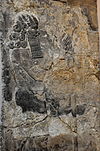 Details
:
Details
:
Lahmu
is a protective and beneficent god whose name means
"Hairy". He was originally associated with Enki
and later with Marduk. During the Neo-Assyrian Period
(911 BC – 609 BC), figurines of Lahmu, who is depicted
with long hair and a long, curled beard, were placed
under the foundations of houses and temples to protect
against demons and pestilence. Lahmu is closely
associated with the kusarikku or "bull-man".
In the Babylonian Enűma Eliš, Lahmu and his
consort Lahamu are a primordial couple. Their names
are derived from the same root. |
| Lamashtu
|
 Details
:
Details
:
Lamashtu
was a goddess with the "head of a lion, the teeth
of a donkey, naked breasts, a hairy body, hands
stained (with blood?), long fingers and fingernails,
and the feet of Anzű." She was believed to feed
on the blood of human infants and was widely blamed
as the cause of miscarriages and cot deaths. Although
Lamashtu has traditionally been identified as a
demoness, the fact that she could cause evil on
her own without the permission of other deities
strongly indicates that she was seen as a goddess
in her own right. Mesopotamian peoples protected
against her using amulets and talismans. She was
believed to ride in her boat on the river of the
Underworld and she was associated with donkeys.
She was believed to be the daughter of An. |
| Lisin
|
Major
cult centers : Adab and Kesh
Details
:
A
popular, but not very important god, who was worshipp
Lisin
and her brother Ashgi were worshipped in Adab and
Kesh. Her husband was the god Ninsikila. In Sumerian
times, Lisin was viewed as a mother goddess. She
is identified with the star a Scorpionis. Later,
Ninsikila was accidentally mistranslated as the
name of a goddess and Lisin accordingly became treated
as a god. |
| Lugalbanda |
Major
cult centers : Uruk, Nippur, and Kuara
Details
:
A
popular, but not very important god, who
was worshipp Lugalbanda
was an early legendary king of the Sumerian city-state
of Uruk, who was later declared to be a god. He
is the husband of the goddess Ninsun and the father
of the mortal hero Gilgamesh. He is mentioned as
a god alongside Ninsun in a list of deities as early
as the Early Dynastic Period. A brief fragment of
a myth about him from this same time period is also
preserved. During the Third Dynasty of Ur, all the
kings would offer sacrifices to Lugalbanda as a
god in the holy city of Nippur. Two epic poems about
Lugalbanda describe him successfully crossing dangerous
mountains alone, though hindered by severe illness.
The Sumerian King List makes him a shepherd, who
reigned for 1,200 years. He has a close relationship
with the goddess Inanna. |
| Lugal-irra
and Meslamta-ea |
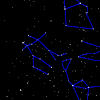
Major
cult centers : Kisiga
Details
:
Lugal-irra
and Meslamta-ea are a set of twin gods who were
worshipped in the village of Kisiga, located in
northern Babylonia. They were regarded as guardians
of doorways and they may have originally been envisioned
as a set of twins guarding the gates of the Underworld,
who chopped the dead into pieces as they passed
through the gates. During the Neo-Assyrian period,
small depictions of them would be buried at entrances,
with Lugal-irra always on the left and Meslamta-ea
always on the right. They are identical and are
shown wearing horned caps and each holding an axe
and a mace. They are identified with the constellation
Gemini, which is named after them. |
| Lulal
|
Major
cult centers : Bad-tibira
Details
:
A
popular, but not very important god, who was worshipp
Lulal is a god who is closely associated with Inanna,
but their relationship is unclear and ambiguous.
He appears in Inanna's Descent into the Underworld.
He seems to have primarily been a warrior-god, but
he was also associated with domesticated animals. |
| Mami
or Mama |
Details
: Mami
or Mama is a mother goddess whose name means "mother".
She may be the same goddess as Ninhursag. |
| Mandanu |
Details
: Mandanu
is a god of divine judgement who was worshipped
during the Neo-Babylonian Period. |
| Martu
|
Details
: Martu,
later known as Amurru (Amorite), is a god
who destroys cities and "rages over the land like
a storm". He is the personification of the nomads
who began to appear on the edges of the Mesopotamian
world in the middle of the third millennium BC,
initially from the west, but later from the east
as well. One myth describes how the daughter of
the god Numušda insists on marrying Martu, despite
his unattractive habits. In Old Babylonian and Kassite
art, Amurru is shown as a god dressed in long robes
and carrying a scimitar or a shepherd's crook. |
| Misharu |
Details
: Misharu
is the son of Utu and Sherida. His name means "Justice". |
| Nanaya
|

Major
cult centers : Uruk and Kish
Details
:
Nanaya
was originally a goddess of lust and sexuality who
shared many of her aspects with Inanna. During the
Old Babylonian Period, she and Inanna, as well as
her daughter Kanisura, were worshipped as a trinity
of goddesses in Uruk and later in Kish. In later
times, Nanaya was completely assimilated into Inanna
and her name became merely one of Inanna's many
cultic epithets. |
| Neti
|
Details
: Neti
is the gatekeeper of the Underworld. In the story
of Inanna's Descent into the Underworld,
he leads Inanna through the seven gates of the Underworld,
making sure that when she comes before Ereshkigal
she is symbolically powerless. |
| Ningikuga
|
Details
: Ningikuga
is a goddess of reeds and marshes. Her name means
"Lady of the Pure Reed". She is the daughter of
Anu and Nammu and one of the many consorts of Enki. |
| Nin-imma
|
Details
: Nin-imma
is the divine personification of female genitalia.
Her name literally means "lady female genitals".
She appears in one version of the myth of Enki
and Ninsikila in which she is the daughter of
Enki and Ninkurra. Enki rapes her and causes her
to give birth to Uttu, the goddess of weaving and
vegetation. |
| Nindara |
Details
: Nindara
is a minor god who was sometimes considered the
consort of the goddess Nanshe. |
| Ningilin
|
 Details
:
Details
:
Ningilin
is a deity who was associated with mongooses, which
are common throughout southern Mesopotamia. who
was conflated at an early date with Ningirima, a
god of magic invoked for protection against snakes.
She is probably a goddess, but might have sometimes
been considered a god. She was so closely associated
with mongooses that the Akkadian word for "mongoose"
was later written using the Sumerian symbol for
her name. According to a Babylonian popular saying,
when a mouse fled from a mongoose into a serpent's
hole, it announced, "I bring you greetings from
the snake-charmer!" A creature resembling a mongoose
also appears in Old Babylonian glyptic art, but
its significance is not known. |
| Ningirima
|
Details
: Ningirama
was a deity associated with magic who was invoked
for protection against snakes. He or she was conflated
with Ningilin, the deity of mongooses, at an early
date. |
| Ninkasi
|
Details
: Ninkasi
is the ancient Sumerian tutelary goddess of beer.
|
| Ninkurra |
Details
: Ninkurra
is the daughter of Enki and Ninsar. After having
relationship with Enki, Ninkurra gave birth to Uttu,
the goddess of weaving and vegetation. |
| Ninmena
|
Details
: Ninmena
is a Sumerian mother goddess whose name means "Lady
of the Crown". She may just be another name for
Ninhursag. |
| Ninmug
|
Details
: Ninmug
is the wife of the god Ishum or the god Hendursag,
who may be the same deity. |
| Ninnisig
|
Details
: Ninnisig
is the wife of Erragal. |
| Ninsar
|
Details
: Ninsar
is the daughter of Enki and Ninhursag. After relationship
with Enki, Ninsar gave birth to Ninkurra. |
| Ninsianna |

Major
cult centers : É-eš-bar-zi-da temple in Ur and other
temples in Sippar, Larsa, and Uruk
Details
:
Ninsianna
is the Sumerian deity of the planet Venus. She was
originally a goddess, but was sometimes later viewed
as a god. She is described in one text as the "holy
torch who fills the heavens" and was frequently
associated with haruspicy. Her worship is first
attested during the Third Dynasty of Ur and she
continued to be venerated until the Seleucid Period
(312 BC – 63 BC). Especially in later texts, she
is often subsumed as an aspect of Inanna-Ishtar. |
| Ninsikila |
Details
: Ninsikila
is the husband of the goddess Lisin. Later, his
name was mistranslated as the name of a goddess
and he became regarded as female. |
| Ninsun |
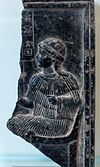
Major
cult centers : Uruk
Details
:
Ninsun
is the divine consort of Lugalbanda, the deified
king of Uruk, and the mother of the hero Gilgamesh. |
| Nintu
|
Details
: Nintu
is a Sumerian mother goddess associated with childbirth.
Her name literally means "Lady of Birth". She may
just be an aspect of Ninhursag. |
| Nirah
|
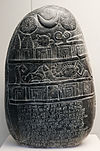
Major
cult centers : Der
Details
:
Nirah
is the sukkal, or personal attendant, of
the god Ištaran. He was identified with snakes and
may appear in the form of a snake on kudurrus. |
| Numushda |
Major
cult centers : Kazallu
Details
: Numushda
is a god who was associated with the city of Kazallu.
His worship is attested from the Early Dynastic
Period, but his cult seems to have ceased at the
end of the Old Babylonian Period. He was believed
to be the son of the moon-god Nanna and may have
been regarded as a storm deity. In the myth of The
Marriage of Martu, Numushda's unnamed daughter
insists on marrying the nomadic desert god Martu,
despite his unattractive lifestyle. |
| Nungal
|
Major
cult centers : Ekur temple in Nippur
Details
: Nungal,
also known as Manungal, was the daughter of Ereshkigal.
Her husband was the god Birtum. She later became
seen as an aspect of Nintinugga. |
| Nusku
|
Major
cult centers : Harran
Details
: Nusku
is the god of fire and light. He was the son and
minister of Enlil. The god Gibil is sometimes described
as his son. Nusku's main symbol was a lit oil lamp.
He was a member of a group of deities that were
worshipped in Harran during the Neo-Assyrian Period
by the predominately Old Aramaic-speaking population
there. |
| Pabilshag |
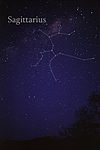
Major
cult centers : Isin, Nippur, and Larag
Details
:
Pabilshag
is a god whose worship is attested from the Early
Dynastic Period onwards. He was believed to be the
son of Enlil and the husband of Ninisina, the patron
goddess of Isin. In some texts, he is identified
with Ninurta or Ningirsu. One Sumerian poem describes
Pabilshag's journey to Nippur. Pabilshag was believed
to be the constellation Sagittarius. |
| Pazuzu |
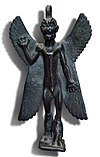 Details
:
Details
:
Ningilin
is a deity who was associated with mongooses, which
are common throughout Pazuzu is a demonic god who
was well known to the Babylonians and Assyrians
throughout the first millennium BC. He is shown
with "a rather canine face with abnormally bulging
eyes, a scaly body, a snake-headed penis, the talons
of a bird and usually wings." He was believed to
be the son of the god Hanbi. He was a beneficent
entity who protected against winds bearing pestilence
and he was thought to be able to force Lamashtu
back to the Underworld. Amulets bearing his image
were positioned in dwellings to protect infants
from Lamashtu and pregnant women frequently wore
amulets with his head on them as protection from
her. Ironically, Pazuzu appears in The Exorcist
films as the demon that possesses the little girl. |
| Šarrat-Deri |
Major
cult centers : Der
Details
: Šarrat-Deri
is the wife of Ištaran, the local god of the Sumerian
city-state of Der. Her name means "Queen of Der". |
| Shara
|
Major
cult centers : E-mah temple in Umma and possibly also
Tell Agrab
Details
: Shara
was a local deity associated with the city of Umma,
where his main temple was the E-mah. A fragment
of a stone bowl inscribed with his name discovered
in the rubbish dump at Tell Agrab, northeast of
Babylon, indicates that he may have also been worshipped
there. He was also a warrior god and is referred
to as a "hero of An". In the Babylonian myth of
Anzű, Shara is one of the warrior gods who is asked
to retrieve the Tablet of Destinies, but refuses.
In Inanna's Descent into the Underworld,
Shara is one of the three deities who come to greet
her upon her return. In the myth of Lugalbanda and
in a single building inscription from the Third
Dynasty of Ur, Shara is described as Inanna's "son",
a tradition which runs directly contrary to the
usual portrayal of Inanna as youthful and without
offspring. |
| Sherida
|
Major
cult centers : Sippar and Larsa
Details
: Sherida,
later known as Aya, was the goddess of light and
the wife of the sun-god Utu. She was closely associated
with sexuality and fertility. She was especially
popular during the Old Babylonian Period and the
Neo-Babylonian Period (626 BC – 539 BC). |
| Shullat |
Details
: Shullat
was an attendant of the sun god Shamash. His function
as an attendant was in the capacity of personal
security of the greater god Adad, as described and
shown tablet 11 lines 98-100 of the Epic
of Gilgamesh (together with Hanish fulfilling a
dual function in that capacity). |
| Shul-pa-e
|
Details
: Shul-pa-e's
name means "youthful brilliance", but he was not
envisioned as youthful god. According to one tradition,
he was the consort of Ninhursag, a tradition which
contradicts the usual portrayal of Enki as Ninhursag's
consort. In one Sumerian poem, offerings are made
to Shul-pa-e in the Underworld and, in later mythology,
he was one of the demons of the Underworld. |
| Shul-utula
|
Details
: Shul-utula
was a tutelary deity known only as the personal
deity to Entemena, king of the city of Eninnu. |
| Sirtur
|
Details
: Sirtur
was a goddess of sheep known from inscriptions and
passing comments in texts. She eventually became
syncretised with the goddess, Ninsun. In some texts,
she is described as the mother of Dumuzid. |
| Šul-šagana |
Major
cult centers : Lagash
Details
: Šul-šagana
is the son of Bau and Ningirsu. |
| Siduri
|
Details
: Siduri
is a wise goddess who was believed to keep an alehouse
at the edge of the world. In the earlier Old Babylonian
versions of the Epic of Gilgamesh, she attempts
to dissuade Gilgamesh from his quest for immortality,
instead urging him to be content with the simple
pleasures in life. Her name means "She is my Rampart". |
| Silili
|
Details
: Silili
is an obscure goddess who was apparently the mother
of all horses. She is only attested once in the
Epic of Gilgamesh. |
| Sumugan |
Details
: Sumugan
is an obscure "god of the plain", who is briefly
referenced in the Sumerian poem The Dispute between
Cattle and Grain. |
| Tashmetu |
Major
cult centers : Kalhu
Details
: In
Assyrian mythology, Tashmetu is the divine consort
of Nabu, the god of scribes and wisdom; in Babylonian
mythology, this role is instead assigned to the
goddess Nanaya. Tashmetu is associated with wisdom
and sexual attractiveness, a quality which she shares
with Inanna and Nanaya. A poetic composition from
the Library of Ashurbanipal describes how, in one
ritual, Nabu and Tashmetu's statues would be brought
together for a "marriage ceremony". One extant letter
describes how, after their wedding, Tashmetu and
Nabu stayed in the bedchamber for six days and seven
nights, during which time they were served an elaborate
feast. Tashmetu is attested relatively late and
is not mentioned in texts prior to the Old Babylonian
Period. |
| Uraš
|
Details
: Uraš
is the earliest attested consort of Anu; she is
described in Sumerian texts dating to the third
millennium BC. Her role as Anu's consort was later
ascribed to Ki, the personification of the earth. |
| Uttu
|
 Details
:
Details
:
Uttu
is the Sumerian goddess of weaving. The same cuneiform
symbol used to write her name was also used to write
the Sumerian word for "spider",indicating that Uttu was probably envisioned
as a spider spinning a web. She appears primarily
in the myth of Enki and Ninsikila, in which
she resists the sexual advances of her father Enki
by ensconcing herself inside her web, but he convinces
her to let him in using a gift of fresh produce
and the promise that he will marry her. Enki then
intoxicates her with beer and rapes her. She is
rescued by Enki's wife Ninhursag, who removes Enki's
semen from her vagina and plants it in the ground,
resulting in the growth of eight new plants, which
Enki later eats. |
| Zababa |
Major
cult centers : E-mete-ursag temple in Kish
Details
:
Zababa
is a local god associated with the city of Kish,
near Babylon. The earliest attestation of Zababa
comes from the Early Dynastic Period. Zababa was
a god of war and he was syncretized with the god
Ninurta, who was also known as Ningirsu. In one
list of deities he is called "Marduk of battle".
His primary symbol was a staff with the head of
an eagle. |
|
Foreign
deities in Mesopotamia :
Name |
Particulars |
| Astarte
|
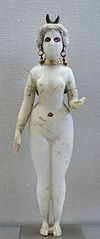
Place
of origin : Levant
Details
:
Astarte
is a West Semitic goddess of warfare, whose name
is cognate to the one belonging to the East Semitic
goddess Ishtar. She and Ishtar had many qualities
in common, but Astarte was more closely associated
with warfare, while Ishtar was more closely associated
with love and sexuality. The two goddesses were
eventually syncretized. |
| Atargatis |

Place
of origin : Syria
Details
:
Atargatis
is a Syrian goddess who was worshipped in the early
centuries AD. Her main cult center was her temple
in the city of Hierapolis, which a Jewish rabbi
later listed as one of the five most important pagan
temples in the Near East. Her cult was apparently
highly influential during the Roman Period, but
the only source describing the rituals associated
with her in detail is the satirical essay On
the Syrian Goddess, written in the second century
AD by the Hellenized Syrian Lucian. Lucian's treatise
is primarily a work of satire making fun of the
arbitrary cultural distinctions between "Greeks"
and "Assyrians" by emphasizing the manner in which
Syrians have adopted Greek customs and thereby effectively
become "Greeks" themselves. Scholars therefore dispute
whether the treatise is an accurate description
of Syrian cultural practices and very little is
known about Hierapolis other than what is recorded
in On the Syrian Goddess itself. |
| Aglibol
|
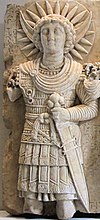
Place
of origin : Palmyra,
Syria
Details
:
Aglibol
is the Palmyrene god of the moon. He was worshipped
alongside Malakbel, the god of the sun. |
| Baalshamin |
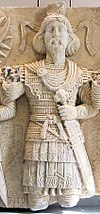
Place
of origin : Syria
Details
:
Baalshamin
is an originally Canaanite deity whose cult spread
throughout much of Syria. He is the god of fertile
soil and clear skies. His name means "Lord of Heaven"
and the heavens were thought to belong to him. He
was a supreme god of weather and rain. |
| Bel
of Palmyra |

Place
of origin : Levant
Details
: Palmyra,
Syria
A
god under the title "Bel", distinct from the Babylonian
god with the same title, was worshipped as the chief
god of the Palmyrene pantheon in Syria during the
late first millennium BC. He is first attested under
the name Bol, but, after the Babylonian cult
of Marduk-Bel was introduced to Palmyra in around
213 BC, he was renamed as "Bel". |
| Bes
|
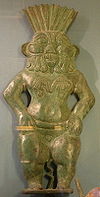
Place
of origin : Egypt
Details
:
Bes
is an Egyptian god of play and recreation. He was
envisioned as a "full-faced, bow-legged dwarf with
an oversized head, goggle eyes, protruding tongue,
bushy tail and usually a large feathered crown as
a head-dress." Representations of an almost identical
dwarf-god became widespread across the Near East
during the first millennium BC and are common in
Syria, Palestine, and Arabia. This god's name in
Assyrian and Babylonian may have been Pessű. Bes
seems to have been the only Egyptian god who became
widely worshipped throughout Mesopotamia. |
| Humban |
Place
of origin : Elam
Details
:
Hamban,
later known as Napirisha, is the Elamite god of
the sky. His name means "Great God". |
| Hutran
|
Place
of origin : Elam
Details
:
Hutran
is an Elamite god who was believed to be the son
of Kiririsha and Napirisha.
|
| Inshushinak |
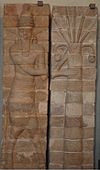
Place
of origin : Elam
Details
:
Inshushinak
is an Elamite god was originally the patron god
of the city of Susa, but later became a major underworld
deity. |
| Inzak
|
Place
of origin : Dilmun
Details
:
The
Sumerians regarded Inzak as the chief god of the
Dilmunite pantheon, but the Dilmunites themselves
regarded him as a god of Agaru, a land in eastern
Arabia. His main cult center was on Failaka Island,
where a temple was dedicated to him. During the
Neo-Babylonian Period, Inzak was identified with
Nabu. |
| Lagamal
and Ishmekerab |
Place
of origin : Elam
Details
:
Lagamal
and Ishmekerab are twin Elamite goddesses who were
believed to serve as judges of the dead in the Underworld. |
| Malakbel
|
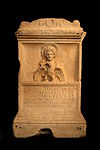
Place
of origin : Palmyra,
Syria
Details
:
Malakbel
is the Palmyrene god of the sun. He was worshipped
alongside Aglibol, the god of the moon. |
| Meskilak
|
Place
of origin : Dilmun
Details
:
Meskilak
is the patron goddess of the city of Dilmun. She
may have been seen as the wife or mother of Inzak.
The Sumerians seem to have identified her with Ninhursag.
She is sometimes referred to as Nin-Dilmun, meaning
"Lady of Dilmun". |
| Muati
|
Place
of origin : Dilmun
Details
:
Muati
is an obscure Dilmunite god who is referenced in
some Sumerian texts. He was later syncretized with
Nabu. |
| Nahhunte
|
Place
of origin : Elam
Details
:
Nahhunte
is the Elamite god of the sun and justice. |
| Napir
|
Place
of origin : Elam
Details
:
Napir
is the Elamite god of the moon. |
| Pienenkir
|
Place
of origin : Elam
Details
:
Pienenkir,
later known as Kiririsha, is a mother goddess, who
was worshipped by the Elamites. Her name means "Great
Goddess". |
| Lahamun
|
Place
of origin : Dilmun
Details
:
Lahamun
is a Dilmunite goddess who is described in Mesopotamian
texts as the "Sarpanitu of Dilmun". |
| Manzât
|
Place
of origin : Elam
Details
:
Manzât
is the wife of the Elamite god Simut. |
| Ruhurater,
Kilahšupir, and Tirutir |
Place
of origin : Elam
Details
:
Ruhurater,
Kilahšupir, and Tirutir are a group of local, Elamite
deities. |
| Siyâšum,
Narunte, and Niarzina |
Place
of origin : Elam
Details
:
Siyâšum,
Narunte, and Niarzina are the three sisters of the
Elamite goddess Kiririsha. |
| Simut
|
Place
of origin : Elam
Details
:
Simut
is an Elamite god who serves as a herald. |
Yahweh
El, Elohim, El Shaddai, Yah |

Place
of origin : Kingdoms
of Israel and Judah
Details
:
Yahweh
was the national god of the Israelites, who originally
lived in the Levantine kingdoms of Israel and Judah.
In 586 BC, the Neo-Babylonian king Nebuchadnezzar
captured Jerusalem, destroyed the Temple of Solomon,
and deported the elite members of Judahite society
to Babylon in an event known as the "Babylonian
exile". Modern scholars generally agree that much
of the Deuteronomistic History was probably edited
and redacted by Judahite priests living in Babylon
during the exile.The works of Second Isaiah, also written in
Babylon, represent the first unambiguous Judahite
declaration of the non-existence of foreign deities
and proclamation of Yahweh as the sole, supreme
God. Much of the Torah was probably written and
compiled after the exile, when the Jews were allowed
to return to their homeland by the Persians. |
| Yarhibol
|
Place
of origin : Palmyra,
Syria
Details
:
Yarhibol
was originally the Palmyrene god of justice and
morality, but he eventually became regarded as the
god of the sun as well, due to syncretism with the
Babylonian sun-god Shamash. |
|
Source
:
https://en.wikipedia.org/wiki/
List_of_Mesopotamian_deities
|
|
